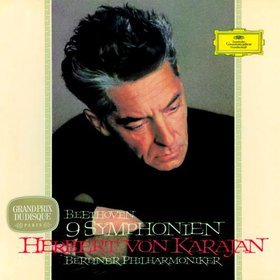Beethoven 9 Symphonies - Berliner Philharmoniker - Herbert von Karajan 1961-62
$
75
$ 75
Sold For
Jul 25, 2012
Sold Date
Jul 22, 2012
Start Date
1
Number Of Bids
USA
Country Of Seller
eBay
Sold at
Favourite Auctions
To save auctions to your favourites, please login
If you don't have an account, please register
Description
9 Symphonien (Berliner Philharmoniker/Herbert von Karajan) [1961-62] Grand Prix du Disque
- Media:Near Mint (NM or M-)
- Sleeve:Near Mint (NM or M-)
LPs in excellent condition; only the 9th symphony LPs appears to have been played. Box is in above average condition. Includes original booklet.
Recorded at Jesus-Christus-Kirche, Berlin on Dec. 1961 (1), Dec. 1961-Jan. 1962 (2), Nov. 1962 (3 & 4), Mar. 1962 (5 & 7), Feb. 1962 (8) and Nov. 1962 (9)
By general consensus, Herbert von Karajan's first (1963) Beethoven cycle for Deutsche Grammophon is the best of the four (!) that he recorded. The Berlin Philharmonic was in top form, and they had not yet made an artistic fetish out of the bland smoothness that typified the conductor's later recordings of this music (and just about everything else). Karajan's squeaky clean, emotionally cool Beethoven will always be something of an acquired taste, but this set makes the best possible case for it. --David Hurwitz
Herbert von Karajan recorded the symphonies of Beethoven four times in his remarkable career -- once with the Philharmonia in the Fifties and three times with the Berlin Philharmonic (1961-2, 1975-7, 1982-5). In many ways, his 60s cycle stands out from the other three. It was the first recording of the Nine to be conceived, planned and sold as an integral set. The initial purchasers had to pay a subscription for the LPs which were sent to them symphony by symphony. Thirty-six years later, this cycle has become somewhat of a benchmark for these cornerstones of the symphonic repetoire. Upon first hearing, I was struck by the tremendous enthusiasm in the playing of the orchestra. I can just imagine the excitement in the recording sessions, one of the finest orchestras of the time conducted by this energetic conductor at the start of what was to become a long tenure. This notion of a great event must have added a frisson to the atmosphere, and it certainly shows here...Isaak Koh
Ah, fame! Beethoven is such a ubiquitous presence that even gangsters, immigrants, and devotees of Mantovani know his name, while bankers, rock hounds and mental patients will regale you with the joke about the origin of the Fifth Symphony in a landlady's odd laugh — Ha-ha-ha-huh! And because so much of his work is surefire, it communicates even when performed by bush league bands and amateurs. Which is to say that he is both superficially known and badly overexposed. As the trunk of the mighty Beethoven tree, the symphonies have been heard so often that, often, they are hardly heard at all. Ha-ha-ha-huh-ho hum. The glut of new Beethoven symphony recordings never ceases — the flood, at least, lasted but 40 days and 40 nights. The original instruments craze promised to deliver Beethoven's work with pristine authenticity by taking us back to limitations the composer manifestly sought to transcend. Meanwhile, we rummage among the rich trove of artifacts left by the great interpreters of the past — Mengelberg, Toscanini, Klemperer, Furtwangler — for revelations of the divine spark animating these Promethean works, and we find them inseparable from the flat, primitive technology of their era. But every generation presents us with a tiny elite of interpretive genius and Herbert von Karajan, born in 1908, had the great good fortune of having been born into a time and place in which his native gifts could play upon a rich inheritance. In the early 1960s, when these recordings were made, Karajan was in his vigorous mid-fifties, only recently at the helm of the Berlin Philharmonic — which he had already made his own— and playing to a superb recording technology. A bloom attended everything he touched. Want the revolutionary Beethoven in all his power and his glory? Try Karajan in his prime...Adrian Corleonis
Symphonie Nr. 1 C-Dur Op. 21A11. Adagio Molto - Allegro Con BrioA22. Andante Cantabile Con MotoA33. Menuetto. Allegro Molto E VivaceA44. Adagio - Allegro Molto E Vivace Symphonie Nr. 2 D-Dur Op. 36B11. Adagio - Allegro Con BrioB22. LarghettoB33. Scherzo. AllegroB44. Allegro Molto Symphonie Nr. 3 Es-Dur Op. 55 »Eroica«C11. Allegro Con BrioC22. Marcia Funebre. Adagio AssaiD13. Scherzo. Allegro VivaceD24. Finale. Allegro Molto Symphonie Nr. 4 B-Dur Op. 60E11. Adagio - Allegro VivaceE22. AdagioF13. Allegro VivaceF24. Allegro Ma Non Troppo Symphonie Nr. 5 C-Moll Op. 67G11. Allegro Con BrioG22. Andante Con MotoH13. AllegroH24. Allegro Symphonie Nr. 6 F-Dur Op. 68 »Pastorale«J11. Erwachen Heiterer Empfindungen Bei Der Ankunft Auf Dem Lande (Allegro Ma Non Troppo)J22. Szene Am Bach (Andante Molto Mosso)K13. Lustiges Zusammensein Der Landleute (Allegro)K24. Gewitter - Sturm (Allegro)K35. Hirtengesang. Frohe Und Dankbare Gefühle Nach Dem Sturm (Allegretto) Symphonie Nr. 7 A-Dur Op. 92L11. Poco Sostenuto - VivaceL22. AllegrettoM13. PrestoM24. Allegro Con Brio Symphonie Nr. 8 F-Dur Op. 93N11. Allegro Vivace E Con BrioN22. Allegretto ScherzandoN33. Tempo Di MenuettoN44. Allegro Vivace IX. Symphonie D-Moll Op. 125O11. Allegro Ma Non Troppo, Un Poco MaestosoP12. Molto VivaceP23. Adagio Molto E CantabileQ14. PrestoAlto Vocals – Hilde Rössel-MajdanBaritone Vocals – Walter BerryChorus – Wiener SingvereinLeader [Einstudierung] – Reinhold SchmidLyrics By – Friedrich SchillerSoprano Vocals – Gundula JanowitzTenor Vocals – Waldemar Kmentt
price rating
